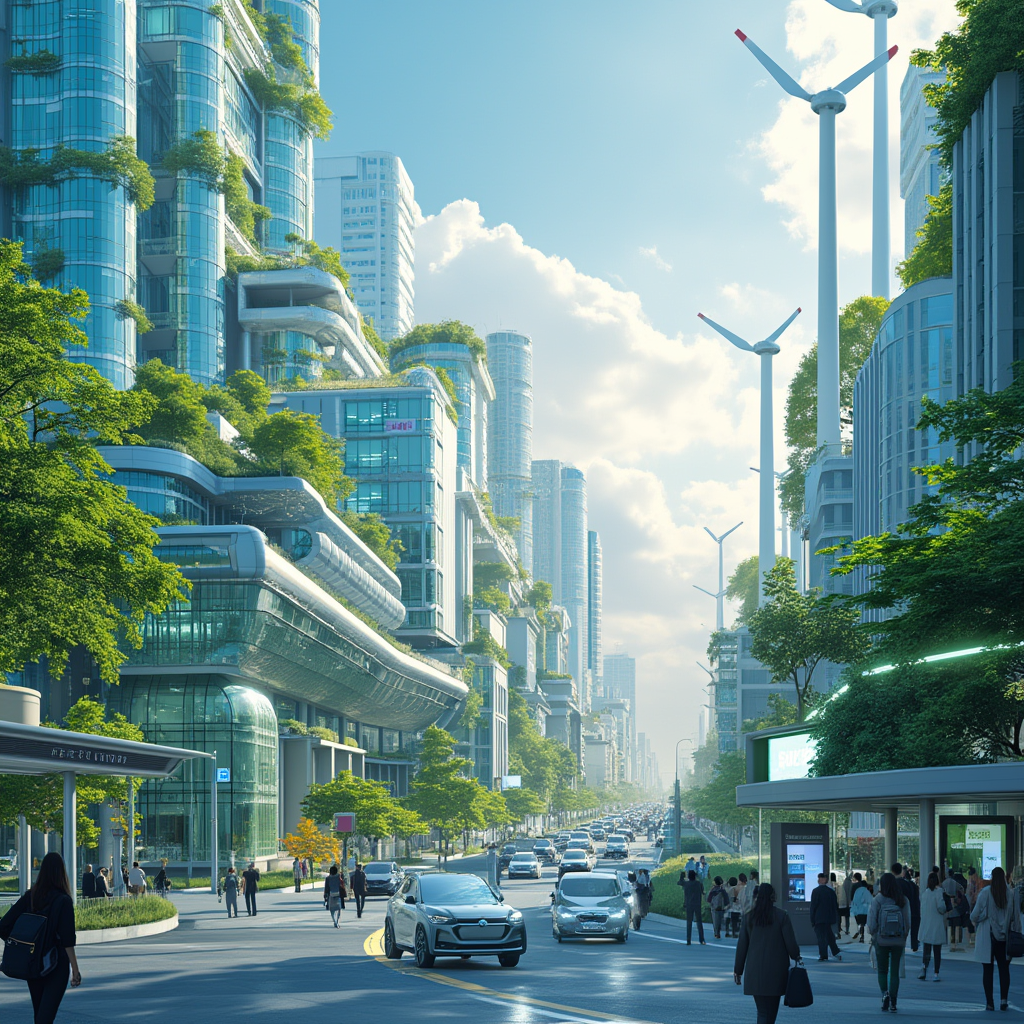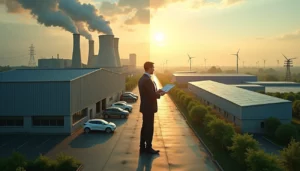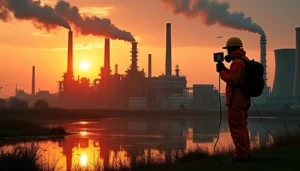Green technology breakthroughs are changing everything faster than ever before. Traditional buildings and construction create 37% of global greenhouse gas emissions. We need cleaner alternatives now more than ever, as shown by the dramatic 82% drop in solar PV electricity costs from 2010 to 2019.
Green technology and sustainability go hand in hand these days. Companies and consumers just need more energy-efficient products and processes. The numbers tell the story – global investment in renewable energy hit $282.2 billion in 2019. Electric vehicles have taken off, too, with 7.2 million cars on the roads by 2019’s end. Carbon capture and storage technology has come a long way and can now trap up to 90% of CO2 emissions from fossil fuels.
The green technologies coming in 2025 will speed up changes in many sectors. From buildings to transport, energy to manufacturing – a green future isn’t just good for the environment. It marks a basic economic transformation. This piece looks at the most promising green technology breakthroughs of 2025, how they’ll affect different industries, and why companies should adopt sustainable technology sooner rather than later.
What is Green Technology Innovation in 2025?
Green technology has evolved in recent years. By 2025, it’s way beyond the reach and influence of isolated environmental solutions. It has become a key driver of economic and social change.
Definition and scope of green technology
Green technology in 2025 covers all state-of-the-art solutions that cut down environmental harm and promote green practices. The technology has products and processes that reduce negative environmental effects. It helps conserve natural resources and supports ecological balance. Expert definitions call it specific advances that lower CO2 emissions. These advances decrease air, water, soil, and noise pollution while protecting natural resources and biodiversity [1].
Green technology’s reach has grown. It now includes both tech and non-tech advances. Tech advances feature renewable energy systems, electric vehicles, and eco-friendly materials. Non-tech advances show up in business practices and better logistics for transportation and resource management [1]. These advances range from small improvements to breakthrough technologies that change how industries work.
Climate tech startups in 2025 do more than clean energy solutions. They work on carbon removal, circular economy ideas, low-emission manufacturing, and climate-ready infrastructure [2]. These different applications reshape many sectors at once. They create a connected network of sustainable solutions.
Why 2025 is a pivotal year for green innovation
The year 2025 marks a turning point for green technology growth. The Intergovernmental Panel on Climate Change (IPCC) says we need quick action to keep global warming under 1.5°C above pre-industrial levels [1]. Governments worldwide have stepped up their environmental goals. They use policies, rules, and incentives to help businesses and people adopt eco-friendly practices [3].
Climate tech ranks among the top three categories for global venture funding in 2025. Investors like its strong growth outlook and friendly policy environment [2]. This surge in investment shows both urgency and potential. About 35% of the needed cut in energy-related CO2 emissions must come from technologies not yet in the market [1].
Big investment firms, sovereign wealth funds, and corporate venture arms put billions into climate technology. They focus on clean hydrogen, battery recycling, precision agriculture, and AI-based energy platforms [2]. Unlike past decades, today’s investors back deep-tech companies. These companies mix hardware, software, and data to create scalable climate solutions with clear returns.
How green technology and sustainability are connected
Green technology and sustainability work together in 2025’s environmental landscape. Sustainability aims to meet today’s needs without hurting future generations. Green technology offers practical tools to reach these goals [4].
Circular economy projects show this connection best. Old economic models followed “take-make-dispose.” New circular economies focus on reusing, repairing, or recycling materials [1]. This change in industrial materials and food systems could cut greenhouse gas emissions by 9.3 billion tons [1].
Green technology helps sustainability in three main ways. It replaces non-renewable resources with renewable ones. It stops environmental damage through prediction. It uses resources better and cuts waste in production [4].
This partnership changes industries significantly. Energy sectors switch from fossil fuels to renewables. Transportation moves to electric and hydrogen vehicles from combustion engines. Farming improves through smart techniques and eco-friendly inputs. Manufacturing benefits from circular processes and green materials [5].
The bond between new ideas and sustainability grows stronger as climate concerns increase. This creates environmental benefits and business opportunities through cost savings, brand value, following rules, and reaching new markets.
Top 5 Green Technology Innovations to Watch in 2025
The year 2025 brings remarkable tech breakthroughs in the environmental sector that create new chances for green development. These five innovations are leading the green revolution. Each one tackles important environmental challenges through clever applications of science and engineering.
1. Low-carbon construction and smart buildings
The construction industry has made a big change toward green practices. Low-carbon construction uses materials that either store CO₂ or cut emissions during production. Companies now employ carbonated aggregates and CO₂-injected concrete to reduce the carbon footprint of construction projects [6]. These processes can create carbon-negative building materials that remove CO₂ from the atmosphere when combined with direct air capture technology [6].
Smart buildings have grown beyond basic automation. The numbers tell the story – from 45 million smart buildings in 2022 to a predicted 115 million by 2026 [7]. These structures employ advanced technology to run and improve essential operations like lighting, HVAC systems, and security [7]. Smart Building as a Service (SBaaS) has become more available without large upfront costs [8].
Buildings with energy-efficient systems and technologies like LED lighting and intelligent HVAC controls reduce their carbon footprint and operating costs [9]. These systems can monitor and adapt to keep optimal air quality standards that support health and productivity [9].
2. Carbon capture and storage systems
Carbon capture, utilization, and storage (CCUS) technologies have reached a vital point in their development. These systems capture CO₂ from industrial sources and either reuse it or store it in geological formations [10]. About 45 commercial capture facilities operate worldwide with a total yearly capture capacity of more than 50 million tons of CO₂ [10].
Past performance fell short of expectations, but momentum has grown. More than 700 projects are now in different stages of development across the CCUS value chain [10]. The total amount of CO₂ captured could reach about 435 million tons per year by 2030 [10].
New innovations include membraneless electrochemically mediated amine regeneration processes that need less energy for carbon capture. This is a big deal as it means that more than 90% CO₂ removal costs around $70 per ton, making it as good as the best amine scrubbing methods [1]. Another breakthrough—a vanadium redox flow system—captures CO₂ while storing renewable energy [1].
3. Long-duration renewable energy storage
Long-duration energy storage (LDES) systems can deliver electricity for 10 or more hours and play a vital role in grid reliability [11]. These system installations will more than double in 2025 compared to the total installed capacity by 2024’s end [12].
This growth matches the rising share of electricity from intermittent renewable sources. LDES stores extra energy during peak generation times and fills gaps when supply drops below what we need [12]. The Long Duration Energy Storage program has invested over $270 million in non-lithium-ion technologies [13].
Form Energy’s 5 MW/500 MWh iron-air energy storage system leads the way. It provides up to 100 hours of continuous power during extreme weather and grid outages [13]. Other technologies gaining ground include compressed air energy storage, gravity-based systems, and flow batteries [14].
4. Hydrogen-powered transport
Hydrogen fuel cell vehicles mark a big step forward in clean transportation. These ultra-efficient vehicles turn pure hydrogen gas into electricity with only water vapor as emission [5]. Major car makers have stepped up their hydrogen technology development.
Toyota has led this field since 1992 and recently joined forces with the EU to build hydrogen fuel corridors across the Trans-European Transport Network [5]. Their new second-generation Mirai can drive up to 400 miles on one tank [5]. BMW has tested its iX5 Hydrogen pilot fleet worldwide, offering 401 horsepower and a range up to 500 kilometers [5].
Heavy-duty transport shows special promise for hydrogen. Toyota and PACCAR work together to develop zero-emission hydrogen fuel cell trucks [5]. These trucks match diesel trucks’ payload capacity but offer better uptime. They need just 15 to 20 minutes to fill up compared to 90 minutes for a 90% battery charge [3].
5. Circular economy and upcycling solutions
The old ‘take, make, use, dispose’ economic model no longer works [15]. The circular economy keeps products and materials in use longer and reduces waste and resource use [15].
The global circular economy market should reach $517.79 billion in 2025. Experts predict it will grow to $798.3 billion by 2029, increasing by 11.4% each year [16]. The EU wants to double Europe’s circularity rate from 12% to 24% by 2030 as part of its Clean Industrial Deal [15].
New approaches include plastic-to-fuel conversion and textile waste upcycling [16]. The construction sector could make $122 billion from recycled concrete alone [17]. Converting 20% of single-use packaging to reusable models worldwide creates a $10 billion opportunity [17]. AI-driven systems, closed-loop design, and policy changes turn waste streams into valuable resources [17].
How Emerging Green Technologies Are Reshaping Industries
Green technologies are altering the map of industries as they advance from experimental concepts to mainstream adoption. These state-of-the-art solutions create new operational patterns and tackle pressing environmental challenges across sectors.
Energy sector: From fossil fuels to renewables
The energy sector shows a remarkable move away from carbon-intensive sources. Renewables will overtake coal-fired generation in 2025, which signals a radical alteration in global energy production [2]. Wind and solar generation will surpass nuclear power by 2026, and solar PV will become the largest renewable power source globally by 2029, overtaking hydropower [2].
Investment patterns reflect this transformation. Renewable electricity receives policy support in most countries worldwide. The ratio of renewables investment to fossil electricity investment stands at an impressive 10 to 1 [18]. Policy changes in the United States and China have led to a slight downward revision in the global forecast for renewable power capacity growth. The global capacity will still double between now and 2030, with a 4,600 gigawatt increase [19].
Transportation: Rise of electric and hydrogen vehicles
A parallel revolution transforms the transportation sector. Electric vehicle sales reached 17 million worldwide in 2024, growing by more than 25% [20]. The environmental effect proves substantial – the global fleet of electric cars displaced over 1 million barrels of oil consumption daily in 2024 [20].
Hydrogen fuel cell vehicles complement this trend, especially for heavy-duty applications. These ultra-efficient vehicles produce electricity from hydrogen with zero emissions except water vapor [5]. Toyota, which pioneered this field since 1992, has established EU partnerships to create hydrogen fuel corridors across Europe [3]. Commercial vehicles benefit greatly from hydrogen – fuel cell trucks match diesel counterparts’ payload capacity and need only 15-20 minutes to refuel compared to 90 minutes for battery electric vehicles [3].
Agriculture: Smart farming and sustainable inputs
Precision technologies and eco-friendly practices drive agricultural progress. Smart farming combines IoT, artificial intelligence, and data analytics to enhance agricultural operations [4]. These technologies showed remarkable improvements – water usage dropped by 55%, energy consumption fell by 51%, and fertilizer use decreased by 20% compared to traditional methods [4].
AI-driven agricultural systems now predict irrigation demands with 98.4% accuracy and diagnose diseases with 90% precision [4]. High implementation costs and limited technical expertise remain challenging, especially for small-scale farmers [4].
Manufacturing: Eco-friendly materials and processes
The manufacturing sector accepts new ideas through innovative materials and circular processes. Buildings contribute about 34% of global CO₂ emissions and 32% of total energy use [21]. This fact accelerates the transformation in construction materials. The global green building materials market, valued at USD 374.67 billion, will reach USD 894.74 billion by 2032 [21].
Manufacturers adopt energy-efficient machinery, green supply chains, and recycling programs beyond construction [22]. Green steel production technology with a lower carbon footprint represents a vital advancement. Steel production reaches nearly 2 billion tons annually and accounts for about 7% of human greenhouse gas emissions [23]. These innovations prove both environmentally beneficial and vital for economic competitiveness.
Why Businesses Should Care About Green Tech Now
Green technologies mean much more than just making ethical choices for businesses that look ahead. Sustainability initiatives now bring real returns that affect profits directly.
Cost savings through energy efficiency
Energy costs are a major burden for businesses. These expenses rank among the top three costs for 35% of small businesses [24]. Companies that use energy-efficient technologies cut these costs quickly. Organizations using green practices reduce operating costs by up to 60% when they plan well [25]. Small businesses that invest wisely in energy efficiency projects usually cut their utility bills by 10% to 30% [24].
These savings show up everywhere. Energy-efficient buildings could save about $1.2 trillion over the next ten years [25]. Simple changes like putting solar panels on roofs can slash electricity bills [26]. Energy storage solutions also help businesses handle peak-hour electricity costs better [26].
Improved brand image and ESG performance
Customer priorities have moved toward sustainability. About 90% of consumers trust and support companies that show environmental progress [27]. Also, 79% choose to buy from brands that back sustainability [25].
This goes beyond buying habits. Most people (76%) think businesses should help fix society’s problems [27]. ESG performance boosts company value, especially for small and low-growth companies [28]. Companies that use green practices gain more trust, loyalty, and positive reviews from customers [27].
Access to new markets and green funding
Green technology opens new market opportunities. This sector will grow to $36.6 billion by 2025 [25]. Circular supply chain models could tap into $4.5 trillion in economic value by 2030 [6].
Companies that make sustainability part of their strategy are 1.4 times more likely to create breakthroughs. This leads to unique products and a better market position [6]. Money follows—businesses with better ESG scores earn higher returns (12.9% yearly compared to 8.6% for others) [29].
Money is available to help with this change. The EPA gives out more than $4 billion in grants and support [30]. These incentives, plus tax credits and other government help [24], reduce the original costs of green technologies.
Key Takeaways
Green technology innovations in 2025 represent a critical turning point where environmental necessity meets economic opportunity, transforming industries and creating unprecedented value for forward-thinking businesses.
• 2025 marks a pivotal year: Climate tech has become a top-three venture funding category, with 35% of needed CO2 reductions requiring technologies not yet commercially available.
• Five breakthrough innovations lead the way: Low-carbon construction, carbon capture systems, long-duration energy storage, hydrogen transport, and circular economy solutions are reshaping entire industries.
• Massive cost savings await early adopters: Businesses implementing energy-efficient green technologies can reduce operating costs by up to 60% while cutting utility expenses by 10-30%.
• Consumer demand drives market transformation: 90% of consumers trust environmentally progressive companies more, with the green technology sector projected to reach $36.6 billion by 2025.
• Investment flows favor sustainable businesses: Companies with strong ESG performance achieve 12.9% annual returns compared to 8.6% for traditional counterparts, while accessing billions in green funding opportunities.
The convergence of environmental urgency, technological maturity, and economic incentives makes 2025 the optimal time for businesses to embrace green technology innovations—not just for planetary health, but for competitive advantage and long-term profitability.
FAQs
Q1. Why are green technologies becoming increasingly important in 2025? Green technologies are crucial in 2025 due to their ability to reduce reliance on non-renewable energy sources, mitigate climate change, and conserve fossil fuels. They offer sustainable solutions to pressing environmental challenges while providing economic benefits through cost savings and new market opportunities.
Q2. What are some of the most promising green technology innovations expected in 2025? Key green technology innovations in 2025 include low-carbon construction and smart buildings, advanced carbon capture and storage systems, long-duration renewable energy storage, hydrogen-powered transport, and circular economy solutions. These technologies are reshaping industries and driving sustainable development across sectors.
Q3. How are emerging green technologies transforming different industries? Green technologies are revolutionizing various sectors. In energy, renewables are overtaking fossil fuels. Transportation is shifting towards electric and hydrogen vehicles. Agriculture is adopting smart farming techniques and sustainable inputs. Manufacturing is embracing eco-friendly materials and circular processes, significantly reducing environmental impact.
Q4. What economic benefits can businesses gain from adopting green technologies? Businesses adopting green technologies can achieve substantial cost savings through improved energy efficiency, potentially reducing operating costs by up to 60%. They also benefit from enhanced brand image, improved ESG performance, access to new markets, and increased consumer trust and loyalty.
Q5. How is investment in green technologies evolving? Investment in green technologies is surging, with climate tech becoming one of the top three categories for global venture funding. Businesses with strong environmental performance are achieving higher returns, and substantial funding opportunities are available through grants, tax incentives, and other government support programs to facilitate the transition to sustainable practices.
Our carbon experts help production studios frame strategy, train teams and track results — tailored to operational constraints.





